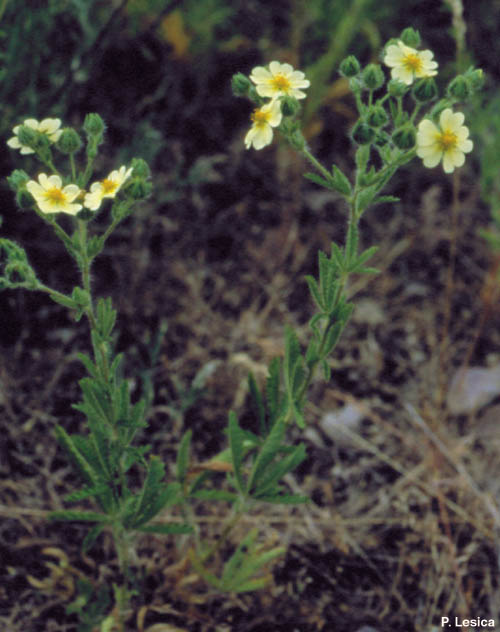-
sulfur cinquefoil
Potentilla recta
Weed ID Links Photo's: Leaves View
 Common Names:
Other common names for the sulfur cinquefoil include:
five-finger cinquefoil, rough-fruited cinquefoil, tall five-finger,
tormentil, upright cinquefoil, and yellow cinquefoil. (7)
Common Names:
Other common names for the sulfur cinquefoil include:
five-finger cinquefoil, rough-fruited cinquefoil, tall five-finger,
tormentil, upright cinquefoil, and yellow cinquefoil. (7)Description:
Roots: The root is one single taproot, a fairly woody root that goes straight down, and several shallow, spreading branch roots. (1)
Stems/Leaves: The leaves of the plant are often mistaken for marijuana leaves, they are ridged on the edges, with 5-7 leaflets on each leaf. They are almost shaped like a hand. The leaf size and leaf stock diminish in size from lower stem to flower. (1) The plant produces several erect stems that can reach 1 to 3 feet in height. (5) The stems are round with long white hairs. (6)
Flowers: Contain five petals, the coloring of the flowers is a pale yellow, and they keep producing flowers all year (growing season) long. (1) The pale yellow petals surround a dark yellow center. (5)
Fruits/Seeds: They have tiny brown seeds that are flat and shaped like a bird beak. Seeds stay viable and may sprout in soil for at least three years. (1)
Method of Reproduction/Spread: Sulfur cinquefoil is spread rapidly by seed. (1)
Life Style/Habits/Life Duration: Sulfur cinquefoil has a long life, and is a perennial occurring every year. This weed can have a life of up to 20-30 years. This is a very competitive weed on grassland and can also become dominant in forest areas. (1) Its habitats include pastures, abandoned fields, vacant lots, gravely areas, and weedy meadows, sulfur cinquefoil prefers disturbed areas. (6)
Environments Favorable to Infestation: This weed is well adapted to dry open range land, pasture areas, and disturbed sites where the ground has been broken up. (1)
Impacts: It will push out plants native to the area, spreads very rapidly, and has a tolerance to drought. (1)
Comments: Most wildlife and livestock won't feed on sulfur cinquefoil. It is loosely related to strawberries. Can produce over 1600 seeds per plant. (4)
Native Range/Probable Entry into North America: Was introduced from Europe and is common in North Idaho and Western Montana. (1)
Methods of Control: For chemical control of this weed, the best results that had 100% accuracy time, were mecoprop, dichlorprop, 2,4-D/dicamba, and dicamba/MCPA/triclopyr were the best results. (2,3)
Biological
control: moths and weevils are being tried at
this
time. (3)
Cultural
Control: To keep control of the amount of sulfur
cinquefoil, it is good to plant cultivated plants. Tilling the
area
is known to work also. (7)
Links:
http://plants.usda.gov/java/profile?symbol=PORE5
http://www.fs.fed.us/database/feis/plants/forb/potrec/all.html
http://montana.plant-life.org/species/poten_rec.htm
http://www.cwma.org/nx_plants/sulf.htm
http://www.invasiveplants.ab.ca/Downloads/SulfurCinquefoil.pdf
http://www.co.whatcom.wa.us/publicworks/pdf/weeds/sulfur_cinquefoil2.pdf
http://www.nwcb.wa.gov/weed_info/Written_findings/Potenilla_recta.html
http://www.co.stevens.wa.us/weedboard/PDF_weed/sc.pdf
http://dnr.metroke.gove/wr/LANDS/weeds/cinque.htm
http://www.ilinoiswildflowers.info/weeds/plants/su_cinqufiol.htm
Bibliography
1) Rees, Norman., et. Al., Ed. Biological Control of Weeds in the West, Western Society of World Science, in cooperation with USDA ARS, MT Department of Ag., and MT state University, Color World Printer.
2) Breitenfeldt, Todd, Personal Interview, Biology Teacher, Whitehall Schools, Box 1109, Whitehall, MT 59759. (406) 287-3862, 9-1-99.
3) Doohan, Doug. Control of Persistent Weed in Grass Forage. [Online] Available: http://agri.gov.ns.ca/pt/projsum/96/ddgras.htm. 9-12-99.
4) unknown. Ministry of Agriculture and Food. [Online]
Available: http://www.af.bc.ca/publicat/pubs_1.htm.
3-12-99.
5) Written Findings of the State Noxious Weed Control
Board. 22 Sept. 2005. 07 Feb. 2007. <http://www.nwcb.wa.gov/weed_info/Written_findings/Potentilla_recta.html>.
6) Illinois Wildflowers. 09 Jan. 2007. John Hilty. 07 Feb.
2007. <http://www.illinoiswildflowers.info/weeds/plants/su_cinquefoil.htm>.
7) Ohio Perennial and Biennial Weed Guide. No posted update. The
Ohio State University OARDC. 07 Feb. 2007. <http://www.oardc.ohio-state.edu/weedguide/singlerecord.asp?id=361>.
Written By: Cara Ryan Published By: Crystal Raue. Updated by: Colton B. 3-2008.
Back mtwow.org HOME